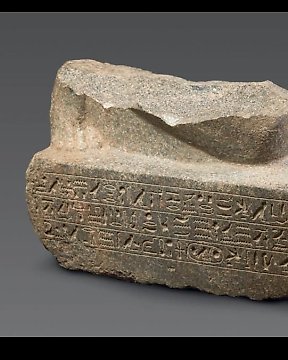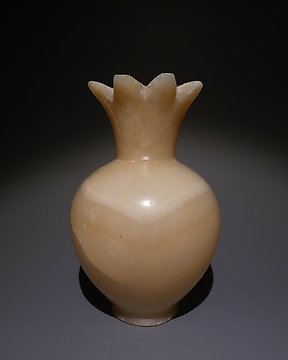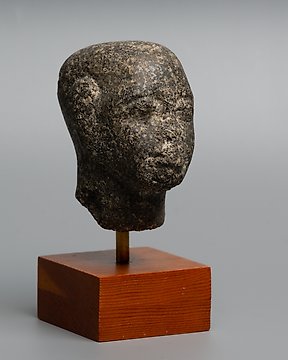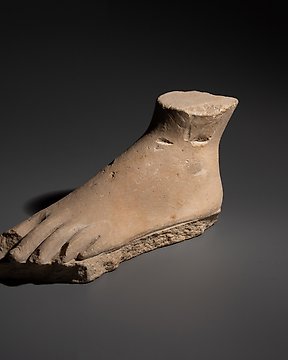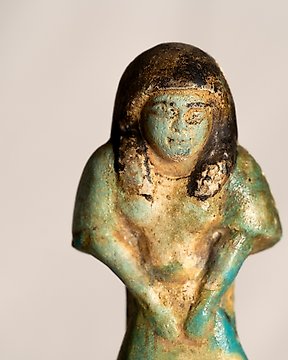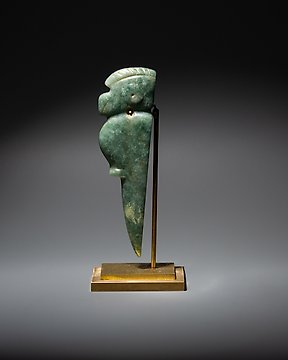Magnifique témoin du passé, envoyé avec tous les justificatifs, impeccable. Encore une fois très satisfait, un grand merci
Προβολή μετάφρασηςΑρχαία Αιγυπτιακή Πέτρα Κεφάλι ενός γλυπτού του θεού Serapis. Πτολεμαιο-Ρωμαϊκή περίοδος, 332 π.Χ. - 1ος αιώνας μ.Χ. 9,5 εκ.
Αρ. 84870751
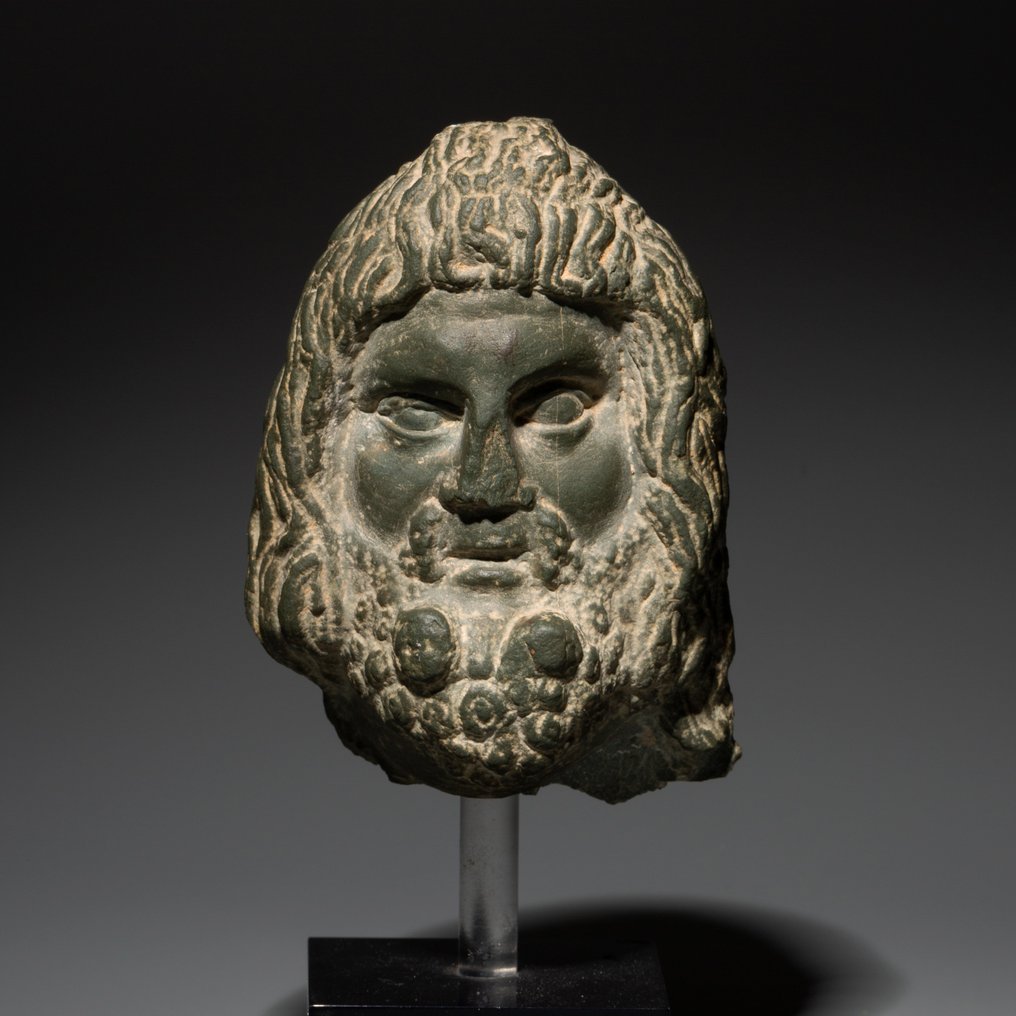

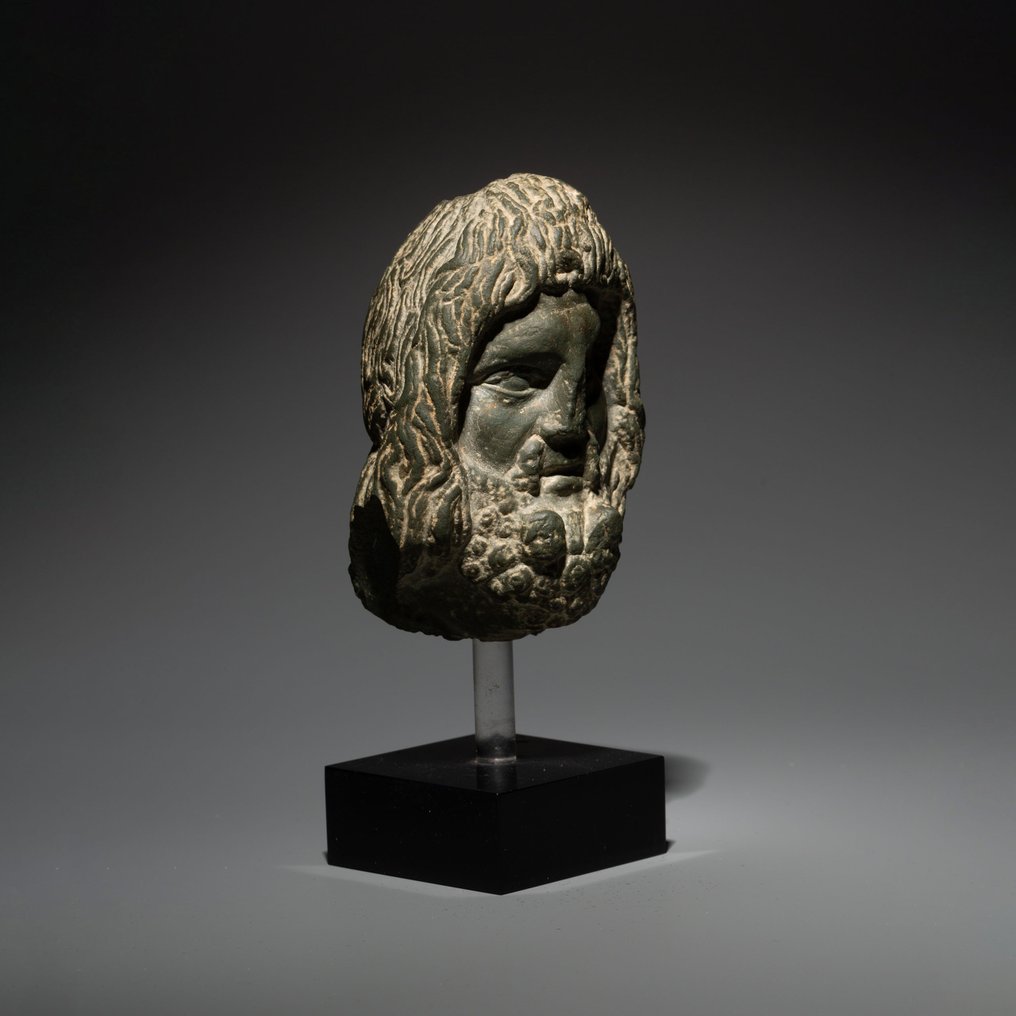
Head of a sculpture of the god Serapis.
- very fine surface -
Ancient Egypt, Ptolemaic-Roman period, 332 BC. - 1st century AD.
Schist.
9.5 cm height, 14 with the stand.
Condition: Good general state of preservation, with wear on the nose.
Provenance: Private collection Paris, France, 1960 - 1970.
Description:
The Cult of Serapis was promoted by Ptolemy I Sotar (Ptolemaic dynasty) as a means of fostering harmony between his Egyptian and Greek subjects. The god combined Osiris and the Apis Bull (the sacred bull of Memphis) with aspects of the Greek gods Zeus (the king of the gods), Dionysus (also known as Bacchus, the god of wine), Helios (the personification of the Sun), Hades (the god of the underworld) and Asklepios (god of medicine).
Linguistically, his name is the result of the fusion of Osiris and Apis, and there is evidence that a cult of Osarapis existed before the Ptolemaic Period, but the Ptolemaic version was a more Greek conception.
Serapis personified divine majesty and represented the sun, fertility, healing, and the afterlife. His consort was Isis, the wife of Osiris and the most popular goddess during the Ptolemaic Period.
Serapis was depicted as a man with an elaborate Greek hairstyle wearing Greek style robes and a full beard. He often wears a corn modius or sheaf on his head. Less often, he is depicted as a serpent in recognition of his connection with the underworld and fertility.
Ptolemy built the Serapeum in Alexandria as the cult center of the new god and it remained the focus of pilgrimage until it was destroyed by the Emperor Theodosius in AD 389. Other smaller shrines and temples were constructed or adapted throughout Egypt, and the cult even spread to Roman territories.
The Serapeum in Saqqara (the home of the Apis bull) grew in popularity with the Greeks thanks to the connection with Serapis, but the native Egyptians never really took to this Hellenized version of Osiris.
Notes:
- The piece includes authenticity certificate.
- The piece includes Spanish Export License (Passport for European Union) - If the piece is destined outside the European Union a substitution of the export permit should be requested, can take between 1-2 weeks maximum.
- The seller guarantees that he acquired this piece according to all national and international laws related to the ownership of cultural property. Provenance statement seen by Catawiki.
Ιστορία πωλητή
Head of a sculpture of the god Serapis.
- very fine surface -
Ancient Egypt, Ptolemaic-Roman period, 332 BC. - 1st century AD.
Schist.
9.5 cm height, 14 with the stand.
Condition: Good general state of preservation, with wear on the nose.
Provenance: Private collection Paris, France, 1960 - 1970.
Description:
The Cult of Serapis was promoted by Ptolemy I Sotar (Ptolemaic dynasty) as a means of fostering harmony between his Egyptian and Greek subjects. The god combined Osiris and the Apis Bull (the sacred bull of Memphis) with aspects of the Greek gods Zeus (the king of the gods), Dionysus (also known as Bacchus, the god of wine), Helios (the personification of the Sun), Hades (the god of the underworld) and Asklepios (god of medicine).
Linguistically, his name is the result of the fusion of Osiris and Apis, and there is evidence that a cult of Osarapis existed before the Ptolemaic Period, but the Ptolemaic version was a more Greek conception.
Serapis personified divine majesty and represented the sun, fertility, healing, and the afterlife. His consort was Isis, the wife of Osiris and the most popular goddess during the Ptolemaic Period.
Serapis was depicted as a man with an elaborate Greek hairstyle wearing Greek style robes and a full beard. He often wears a corn modius or sheaf on his head. Less often, he is depicted as a serpent in recognition of his connection with the underworld and fertility.
Ptolemy built the Serapeum in Alexandria as the cult center of the new god and it remained the focus of pilgrimage until it was destroyed by the Emperor Theodosius in AD 389. Other smaller shrines and temples were constructed or adapted throughout Egypt, and the cult even spread to Roman territories.
The Serapeum in Saqqara (the home of the Apis bull) grew in popularity with the Greeks thanks to the connection with Serapis, but the native Egyptians never really took to this Hellenized version of Osiris.
Notes:
- The piece includes authenticity certificate.
- The piece includes Spanish Export License (Passport for European Union) - If the piece is destined outside the European Union a substitution of the export permit should be requested, can take between 1-2 weeks maximum.
- The seller guarantees that he acquired this piece according to all national and international laws related to the ownership of cultural property. Provenance statement seen by Catawiki.
Ιστορία πωλητή
- 746
- 6
- 0
Thank you for the Special offer and the fast shipping of this excellent piece of art!
Προβολή μετάφρασηςvery good description of the object, very good price for this rare item,. Fast sending (has been at my place 2 days after buying!). Definitely would buy again.
Προβολή μετάφρασηςSehr schön
Προβολή μετάφρασηςAs described, perfect logistic
Προβολή μετάφρασηςgreat seller, everything came as should with certificate of authenticity
Προβολή μετάφρασηςExceptionally well packaged, description aligned with positing received
Προβολή μετάφρασηςReally precious, but without sound...
Προβολή μετάφρασηςPainting well packed and rapidly sent!
Προβολή μετάφρασηςsempre grande rapidità e professionalità
Προβολή μετάφρασηςparfait bien reçu, merci
Προβολή μετάφρασηςVery satisfied with the small Greek Lekythos. As always (we have already bought several items from Bagot), the object was wrapped and sent immediately and with the greatest care.
Προβολή μετάφρασηςPerfect, excellent condition, good packaging, the parcel arrived without any problems… all is perfect as usual. Thank you very much and wait for an other nice piece like this one. Gilles.
Προβολή μετάφρασης+++ Top vendeur professionnel comme d'habitude
Προβολή μετάφρασηςEmbora o custo de transporte esteja acima da média foi, realmente, muito bem executado e em embalagem cuidada. Expeditos e profissionais. Recomendo
Προβολή μετάφρασηςSnel en correct en goed verpakt verzonden
Προβολή μετάφρασηςoggetto bellissimo, fedele alla descrizione, venditore affidabile
Προβολή μετάφρασηςVery nice piece and fast delivery
Προβολή μετάφρασηςEverything ok, top seller! Thank you again!
Προβολή μετάφρασηςvery beautiful and fast shipping!thank you!
Προβολή μετάφρασηςExcelent, very good piece++++
Προβολή μετάφρασηςVendedor increíble muy buenos he comprado muchas veces todo perfecto. Muchas gracias
Προβολή μετάφρασηςpas de problème ; merci beaucoup
Προβολή μετάφρασηςtres rapide conforme hope next +++
Προβολή μετάφρασηςSehr schön! Vielen Dank!
Προβολή μετάφρασης- 746
- 6
- 0
Magnifique témoin du passé, envoyé avec tous les justificatifs, impeccable. Encore une fois très satisfait, un grand merci
Προβολή μετάφρασηςΑποποίηση ευθυνών
Ο πωλητής εγγυάται και μπορεί να αποδείξει ότι το αντικείμενο αποκτήθηκε νόμιμα. Ο πωλητής ενημερώθηκε από την Catawiki ότι έπρεπε να παράσχει τα δικαιολογητικά που απαιτούνται από τους νόμους και τους κανονισμούς στη χώρα διαμονής τους. Ο πωλητής εγγυάται και δικαιούται να πουλήσει/εξάγει αυτό το αντικείμενο. Ο πωλητής θα παρέχει στον αγοραστή όλες τις πληροφορίες προέλευσης που είναι γνωστές για το αντικείμενο. Ο πωλητής διασφαλίζει ότι οποιεσδήποτε απαραίτητες άδειες έχουν ήδη κανονιστεί /θα κανονιστεί. Ο πωλητής θα ενημερώσει αμέσως τον αγοραστή για τυχόν καθυστερήσεις στην απόκτηση τέτοιων αδειών.
Ο πωλητής εγγυάται και μπορεί να αποδείξει ότι το αντικείμενο αποκτήθηκε νόμιμα. Ο πωλητής ενημερώθηκε από την Catawiki ότι έπρεπε να παράσχει τα δικαιολογητικά που απαιτούνται από τους νόμους και τους κανονισμούς στη χώρα διαμονής τους. Ο πωλητής εγγυάται και δικαιούται να πουλήσει/εξάγει αυτό το αντικείμενο. Ο πωλητής θα παρέχει στον αγοραστή όλες τις πληροφορίες προέλευσης που είναι γνωστές για το αντικείμενο. Ο πωλητής διασφαλίζει ότι οποιεσδήποτε απαραίτητες άδειες έχουν ήδη κανονιστεί /θα κανονιστεί. Ο πωλητής θα ενημερώσει αμέσως τον αγοραστή για τυχόν καθυστερήσεις στην απόκτηση τέτοιων αδειών.

